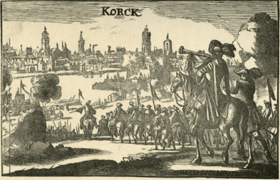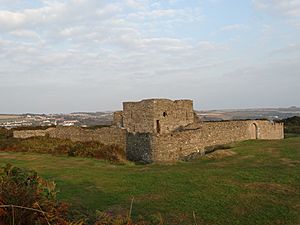Siege of Cork facts for kids
Quick facts for kids Siege of Cork |
|||||||
|---|---|---|---|---|---|---|---|
| Part of the Williamite War | |||||||
 Illustration titled "King William besieging Cork. Fac simile from a contemporary print" in A History of the City and County of Cork (1875) by M F Cusack |
|||||||
|
|||||||
| Belligerents | |||||||
| Commanders and leaders | |||||||
| Duke of Marlborough Duke of Wurttemberg Duke of Grafton † |
Roger McElligott Cornelius O'Driscoll † Sir Edward Scott |
||||||
| Strength | |||||||
| 9,000 troops and a naval fleet | Unknown | ||||||
The Siege of Cork was an important event during the Williamite war in Ireland in 1690. This war was fought because King James II wanted to get his throne back from King William III. The siege happened right after a big battle called the Battle of the Boyne. During the siege, a commander named Marlborough led his troops by land and sea. They successfully took the city of Cork and captured about 5,000 Jacobite soldiers.
Contents
Why the Siege Happened
After the Battle of the Boyne, King William's army took over Dublin. The Jacobite army, who supported King James, moved to the west of Ireland. King William tried to capture Limerick in August 1690, but he was stopped.
To control the southern coast, King William wanted to take the ports of Cork and Kinsale. These ports were important because the Jacobites still held them. So, he sent a strong force led by John Churchill, who was then known as the Earl of Marlborough.
The Sieges of Cork and Kinsale
Taking Cork City
Marlborough and his English forces arrived at Cork by sea on September 21, 1690. He had about 5,000 soldiers and a fleet of ships. These ships blocked the port of Cork, stopping anyone from getting in or out by sea.
Marlborough's troops captured some of the forts protecting the harbor, like Fort Camden. They landed at Passage West on September 24. Then, they set up their main camp at Red Abbey, just south of the city walls.
At the same time, about 4,000 Danish soldiers arrived from the north. They were led by the Duke of Wurttemberg.
Attacking the City Walls
The Williamite forces took control of forts on the hills around Cork, such as Elizabeth Fort. From these high points, they began to fire cannons at the city. After a hole was made in the city walls, the soldiers defending Cork started talking about surrendering. They asked if they could leave Cork and join the main Jacobite army in Limerick. Marlborough said no, even though the Duke of Württemberg thought it was a good idea.
A few days later, the English and Danish troops attacked the hole in the wall together. Henry FitzRoy, Duke of Grafton, a leader, was badly hurt during this attack and later died. Once the Williamite soldiers reached the walls, the Governor of Cork, Roger McElligott, started new surrender talks. He agreed that his soldiers would become prisoners and give up their weapons and supplies. Marlborough accepted, and the city surrendered.
After the Surrender
Even though the city had surrendered, the Williamite troops caused a lot of damage. They looted many homes and treated the Catholic people living there very badly. Many civilians were killed. The Duke of Württemberg and Marlborough had to work hard to bring order back to the city.
Taking Kinsale Forts
After Cork, the Williamites still needed to capture Kinsale. Kinsale was well-protected by two strong forts: the Old Fort, also known as James' Fort, and the New Fort, called Charles Fort.
Marlborough attacked these forts, but he couldn't take them quickly. The Old Fort was defended by Governor Colonel Cornelius O'Driscoll. It fell after an accident: its gunpowder storage area exploded, killing 40 people. About 200 more were killed in the attack that followed, including Colonel O'Driscoll. The remaining soldiers surrendered and were spared.
Charles Fort, however, held out for ten days. It was defended by the experienced Governor Sir Edward Scott and his deputy, Colonel Daniel O'Donovan. The fort only surrendered after its 1,200 soldiers were promised they could march safely to Limerick.


